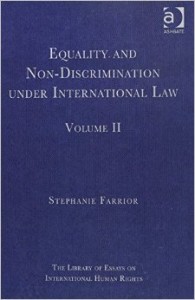For those who might be interested, here is a link to the introductory chapter in a volume of collected works on the subject published this year by Ashgate, part of a five-volume series on International Human Rights:
Equality and Non-Discrimination under International Law
Issues discussed in this chapter include:
- theories of equality;
- formal versus substantive equality;
- structural and institutional inequality;
- the drafting history of human rights treaty provisions on equality and non-discrimination;
- incisive critiques of how UN and regional human rights bodies have interpreted and applied these provisions;
- non-treaty instruments that have influenced international law and practice;
- perspectives on how to determine when difference in treatment is permissible or impermissible under international human rights law;
- what grounds of discrimination are prohibited under international law and why;
- the intersection of multiple grounds of discrimination;
- approaches to determining what special measures, also known as affirmative action, are allowed or even required under human rights law;
- state responsibility for discrimination by non-state actors;
- legal requirements to use non-legal measures to address discrimination, such as governmental programs to address root causes of the prejudice that leads to discrimination.


